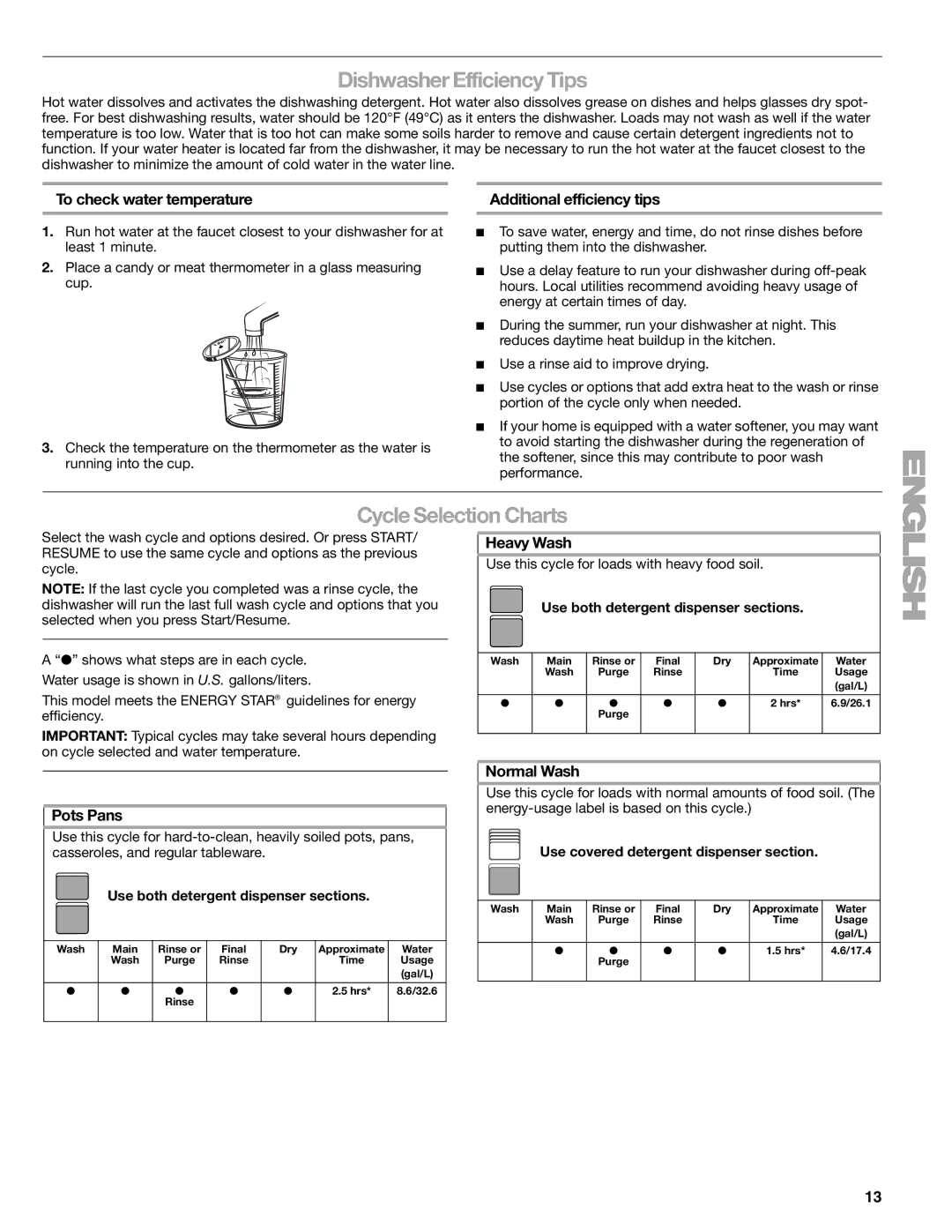
Dishwasher Efficiency Tips
Hot water dissolves and activates the dishwashing detergent. Hot water also dissolves grease on dishes and helps glasses dry spot- free. For best dishwashing results, water should be 120°F (49°C) as it enters the dishwasher. Loads may not wash as well if the water temperature is too low. Water that is too hot can make some soils harder to remove and cause certain detergent ingredients not to function. If your water heater is located far from the dishwasher, it may be necessary to run the hot water at the faucet closest to the dishwasher to minimize the amount of cold water in the water line.
To check water temperature |
| Additional efficiency tips |
1.Run hot water at the faucet closest to your dishwasher for at least 1 minute.
2.Place a candy or meat thermometer in a glass measuring cup.
3.Check the temperature on the thermometer as the water is running into the cup.
■To save water, energy and time, do not rinse dishes before putting them into the dishwasher.
■Use a delay feature to run your dishwasher during
■During the summer, run your dishwasher at night. This reduces daytime heat buildup in the kitchen.
■Use a rinse aid to improve drying.
■Use cycles or options that add extra heat to the wash or rinse portion of the cycle only when needed.
■If your home is equipped with a water softener, you may want to avoid starting the dishwasher during the regeneration of the softener, since this may contribute to poor wash performance.
Cycle Selection Charts
Select the wash cycle and options desired. Or press START/ RESUME to use the same cycle and options as the previous cycle.
NOTE: If the last cycle you completed was a rinse cycle, the dishwasher will run the last full wash cycle and options that you selected when you press Start/Resume.
A “●” shows what steps are in each cycle.
Water usage is shown in U.S. gallons/liters.
This model meets the ENERGY STAR® guidelines for energy efficiency.
IMPORTANT: Typical cycles may take several hours depending on cycle selected and water temperature.
Pots Pans
Use this cycle for
Use both detergent dispenser sections.
Wash | Main | Rinse or | Final | Dry | Approximate | Water |
| Wash | Purge | Rinse |
| Time | Usage |
|
|
|
|
|
| (gal/L) |
|
|
|
|
|
|
|
● | ● | ● | ● | ● | 2.5 hrs* | 8.6/32.6 |
|
| Rinse |
|
|
|
|
|
|
|
|
|
|
|
Heavy Wash
Use this cycle for loads with heavy food soil.
Use both detergent dispenser sections.
Wash | Main | Rinse or | Final | Dry | Approximate | Water |
| Wash | Purge | Rinse |
| Time | Usage |
|
|
|
|
|
| (gal/L) |
|
|
|
|
|
|
|
● | ● | ● | ● | ● | 2 hrs* | 6.9/26.1 |
|
| Purge |
|
|
|
|
|
|
|
|
|
|
|
Normal Wash
Use this cycle for loads with normal amounts of food soil. (The
Use covered detergent dispenser section.
Wash | Main | Rinse or | Final | Dry | Approximate | Water |
| Wash | Purge | Rinse |
| Time | Usage |
|
|
|
|
|
| (gal/L) |
|
|
|
|
|
|
|
| ● | ● | ● | ● | 1.5 hrs* | 4.6/17.4 |
|
| Purge |
|
|
|
|
|
|
|
|
|
|
|
13
